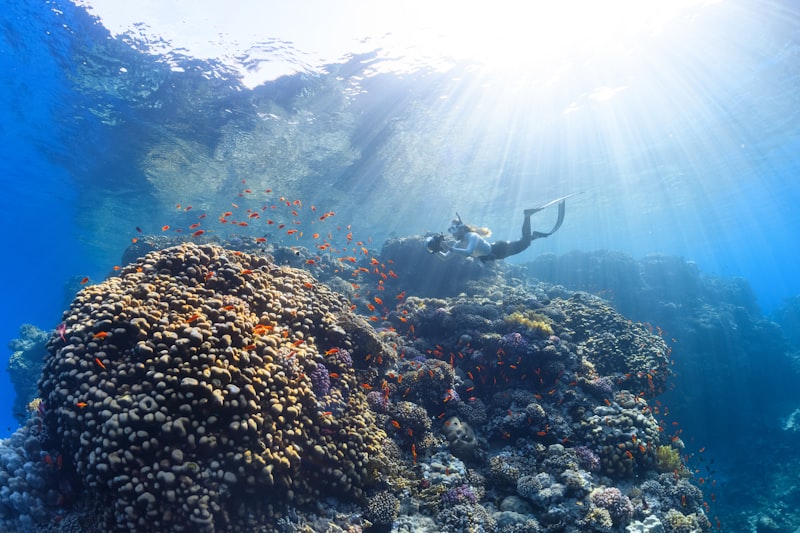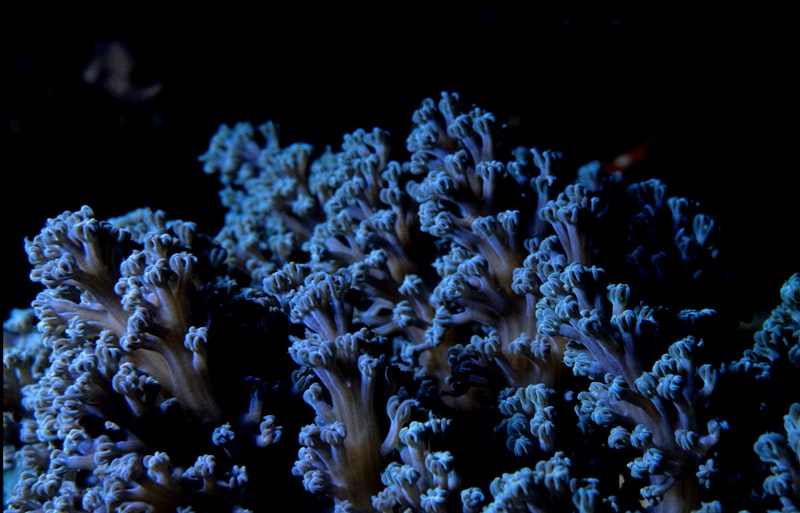Coral reefs are vibrant underwater ecosystems teeming with exotic marine species that captivate scientists and divers alike. These delicate environments, often referred to as the “rainforests of the sea,” harbor a stunning array of life forms ranging from colorful fish to mesmerizing invertebrates.
Among the most fascinating marine species found in coral reefs are the clownfish, known for its striking orange and white stripes, and its unique symbiotic relationship with sea anemones. These small fish dart in and out of the anemone’s tentacles, gaining protection from predators while the anemone benefits from the nutrients in the clownfish’s waste.
Another iconic inhabitant is the parrotfish, which comes in a variety of vibrant colors resembling those of a tropical sunset. These herbivorous fish play a crucial role in maintaining coral reef health by grazing on algae that could otherwise smother the coral.
Divers exploring coral reefs might also encounter the graceful sea turtles gliding effortlessly through the crystal-clear waters. These ancient reptiles return to the reefs to nest, relying on the reefs for food and shelter throughout their lives.
Coral reefs also host an astonishing diversity of invertebrates, such as the brilliantly colored sea stars and sea cucumbers that dot the reef floor. These creatures contribute to the reef’s ecosystem by recycling nutrients and serving as prey for larger predators.
Beyond their ecological importance, coral reefs and their exotic inhabitants hold immense cultural and economic value for coastal communities worldwide. They attract tourists eager to witness their beauty firsthand and provide livelihoods through activities like snorkeling, diving, and eco-tourism.
Protecting coral reefs and the exotic marine species they harbor is crucial for preserving biodiversity and supporting coastal economies. Conservation efforts, including marine protected areas and sustainable tourism practices, are essential to ensure these remarkable ecosystems thrive for future generations to marvel at and enjoy.
Discovering the Hidden Wonders: Exotic Marine Species Thriving in Coral Reefs
Imagine diving into a coral reef and encountering the otherworldly beauty of a Mandarin fish darting among the coral branches like a living gemstone. These fish, known for their vivid colors and intricate patterns, epitomize the wonder of marine biodiversity. They are just one example of how coral reefs host a myriad of species, each uniquely adapted to its environment.
The coral itself, often mistaken for rocks or plants, is a living organism that forms vast underwater structures. These formations provide shelter and food for countless species, creating a bustling community beneath the waves. Coral reefs are not only vital to marine life but also to humans, as they protect coastlines from storms and support fisheries that feed millions around the world.
Among the most charismatic inhabitants of coral reefs are the sea turtles, ancient mariners that navigate the ocean for decades. These gentle giants travel thousands of miles between feeding and nesting grounds, embodying resilience and grace. Their presence reminds us of the interconnectedness of all life in the oceans.
Diving deeper into the coral reef ecosystem unveils creatures like the flamboyant cuttlefish, masters of disguise with their ability to change colors and textures in an instant. They are like underwater chameleons, blending into their surroundings to evade predators or communicate with potential mates.
Unveiling Nature’s Treasures: Rare Exotic Marine Species Identified in Coral Reef Ecosystems
In these vibrant underwater communities, researchers have identified a multitude of species that are not only visually stunning but also play crucial roles in their ecosystems. One such marvel is the Mandarin fish, a tiny jewel of the reef adorned in vibrant hues of orange, blue, and green. Its appearance is akin to an artist’s palette, blending seamlessly with the coral branches it calls home. This fish, with its mesmerizing appearance, reminds us of nature’s boundless creativity.
Venture deeper into the reef, and you might encounter the elusive pygmy seahorse, a creature no larger than a fingernail. Despite its diminutive size, it boasts intricate patterns and hues that camouflage perfectly against the coral polyps. Spotting one of these tiny seahorses is like finding a needle in a haystack, a testament to the reef’s intricate beauty.
As you explore further, the leafy sea dragon emerges like a mythical creature from a fairy tale. Resembling seaweed swaying in the current, this master of disguise glides through the waters with delicate grace. Its appendages mimic leafy extensions, providing it with exceptional camouflage against predators—a true marvel of evolutionary adaptation.
The diversity of rare exotic marine species in coral reef ecosystems serves as a reminder of nature’s resilience and complexity. Each organism plays a vital role in maintaining the delicate balance of these underwater worlds. From the flamboyant Mandarin fish to the cryptic pygmy seahorse and the ethereal leafy sea dragon, these creatures enrich our understanding of marine biodiversity and inspire us to conserve these precious habitats.
Exploring Diversity: Exotic Marine Species Populations Surging in Coral Reefs
Coral reefs, those vibrant underwater cities, are not just home to the usual suspects. Lately, there’s been a fascinating surge in the populations of exotic marine species within these ecosystems. Imagine diving into a kaleidoscope of colors where vibrant parrotfish, graceful lionfish, and elusive seahorses coexist in a delicate dance of survival.
What exactly is causing this surge? Scientists believe it’s a combination of factors. Climate change, surprisingly, has played a role in creating more favorable conditions for some of these species. Warmer waters and altered currents can provide a new habitat for these exotics, turning once-uninhabitable areas into thriving homes.
Human activity also plays a significant part. With increased global travel and trade, exotic species hitch rides on ships or get released from aquariums, finding their way into these delicate reef environments. It’s like an accidental migration, where these creatures adapt and sometimes thrive in their newfound homes.
But why should we care about these newcomers? Well, they bring both opportunities and challenges. On one hand, they enrich the biodiversity of coral reefs, adding new colors and behaviors that divers and researchers alike find endlessly fascinating. Imagine spotting a flamboyant cuttlefish blending with the reef, its colors shifting like a living canvas.
On the other hand, these exotic species can disrupt the delicate balance of reef ecosystems. They may outcompete native species for food or space, potentially causing declines in local biodiversity. It’s a complex dance of adaptation and competition, where only time will tell how these interactions will play out.
From the Depths: Rare Exotic Marine Species Uncovered Among Coral Reefs
Exploring the vibrant underwater world reveals a treasure trove of biodiversity teeming beneath the waves. Coral reefs, often referred to as the rainforests of the sea, harbor an array of fascinating marine life, including some of the rarest and most exotic species known to science. These fragile ecosystems, found in warm, shallow waters, serve as vital habitats for countless organisms.

Among the myriad of species inhabiting coral reefs, there are several that stand out for their rarity and uniqueness. Take, for instance, the Psychedelic Frogfish, a master of camouflage with its kaleidoscopic patterns that blend seamlessly into the colorful coral backdrop. Its ability to mimic its surroundings makes it a challenging find even for seasoned marine biologists.
Delving deeper into the coral labyrinth, one might encounter the elusive Ghost Pipefish, a delicate creature that seems to float ethereally amidst the swaying corals. Resembling a piece of drifting seaweed, its slender body and leaf-like fins allow it to drift effortlessly with the ocean currents.
Not to be outdone in the realm of strange beauty, the Mandarin Fish dazzles with its vibrant hues resembling a living work of art. Found darting amongst the corals at dawn and dusk, it’s a sight coveted by underwater photographers for its stunning appearance.
But the most mysterious of all might be the Deep-Sea Dragonfish, lurking in the twilight zone of the ocean depths. With its bioluminescent lure and fang-like teeth, it embodies the eerie allure of the deep sea, where darkness conceals creatures beyond imagination.

These rare marine species are not only marvels of nature but also indicators of the health of coral reef ecosystems. Their survival depends on the conservation of these delicate habitats, threatened by climate change, pollution, and overfishing.
As we continue to uncover the secrets of coral reefs, each encounter with these rare and exotic species reminds us of the importance of protecting our oceans’ biodiversity. Their existence is a testament to the wonders awaiting discovery beneath the waves, urging us to preserve and cherish these underwater sanctuaries for generations to come.
Frequently Asked Questions
What are some examples of exotic marine species found in coral reefs?
Explore fascinating examples of exotic marine species thriving in coral reefs, showcasing vibrant creatures like the Mandarin fish, Queen angelfish, and the Leafy sea dragon.
What conservation efforts are in place to protect coral reefs from exotic marine species?
Learn about the various conservation efforts implemented to safeguard coral reefs from exotic marine species. Discover how these initiatives aim to preserve biodiversity and maintain the ecological balance crucial for coral reef health.
What threats do exotic marine species pose to native coral reef wildlife?
Learn about the threats posed by exotic marine species to native coral reef wildlife, including competition for resources, predation, and habitat alteration. Understand how these impacts can disrupt the delicate balance of reef ecosystems.
How can divers identify exotic marine species in coral reefs?
Learn how divers can identify exotic marine species in coral reefs using visual cues such as color patterns, distinctive shapes, and unique behaviors. Training in marine biology and underwater photography can enhance identification skills, while field guides and apps like Reef Life can provide valuable reference during dives.
How do exotic marine species contribute to coral reef ecosystems?
Learn how exotic marine species contribute to coral reef ecosystems by understanding their impact on biodiversity, nutrient cycling, and ecosystem resilience.


